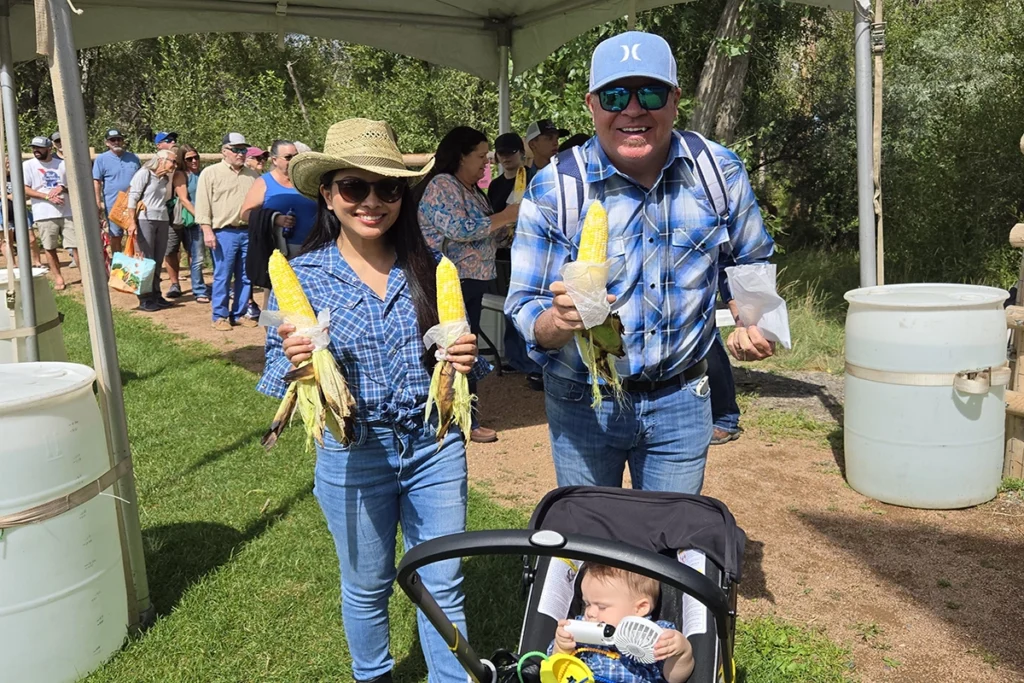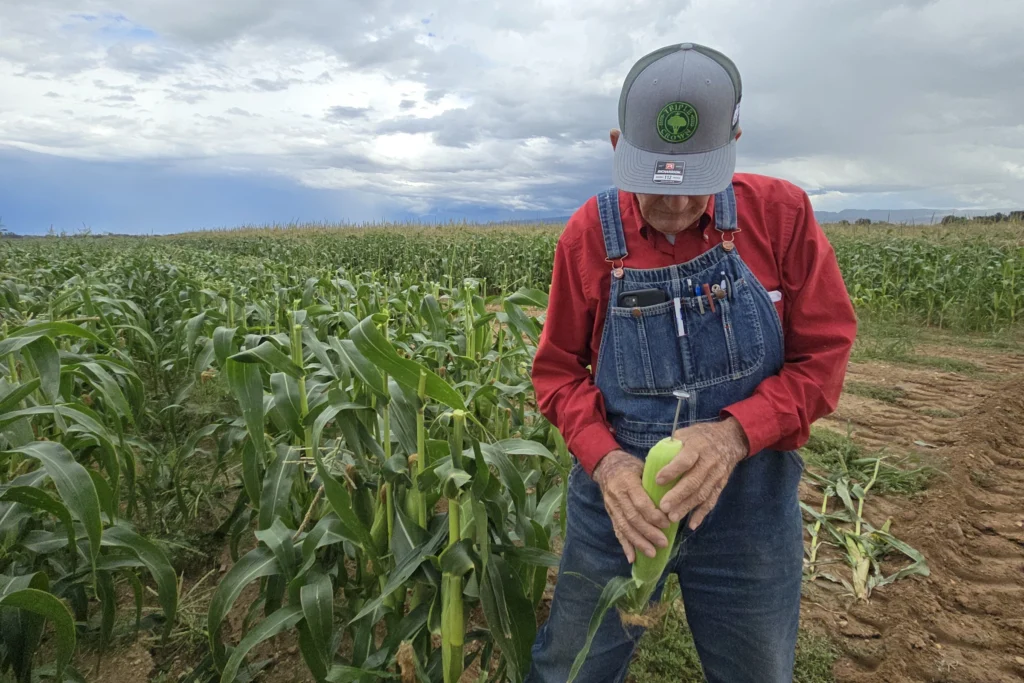At the annual Olathe Sweet Corn Festival each August in western Colorado, the fast-moving line for free ears of tender, roasted sweet corn continues for hours.
“I cannot wait right now,” said an enthusiastic Ruth Goodhart, looking forward to a warm ear of sweet corn handed out by a crew of volunteers.
“We’ve lived all over,” said attendee Mary Goodhart, “and Olathe sweet corn is still the best.”
The Goodharts were part of a group of four women dressed in green and gold attire in honor of the sweet corn festival that they have attended since they were young. The group looks forward to the hometown tradition that celebrates the agricultural heritage of Montrose County as a chance to spend time together.
The women squeezed liquid butter on their corn and joined hundreds of people eating ears of corn at Cerise Park in Montrose at the harvest celebration, which was started in 1990 by area corn growers. Eaters of all ages obviously enjoyed the white-and-yellow bicolor sweet corn on the cob because ears were consumed fully to the folded-down husks.
Keeping the tradition going is a huge motivator for the volunteer committee that puts on the free summer festival with a lineup of events such as a morning 5K run, corn-eating contests, sweet corn princess pageant, car show, vendors, and outdoor music. After years of hosting the event in the small town of Olathe, population 2,000, the festival moved 11 miles to Montrose to the large park to spread out on the grassy lawns. Some 20 community sponsors, including Delta-Montrose Electric Association, help support the festival.
Festival volunteers in 2024 roasted about 8,400 ears of corn that rolled through huge, fiery roasters all day. The corn is donated by family-run Tuxedo Corn company that has more than 40 years of experience growing and shipping sweet corn under the trademark Olathe Sweet.

In August 2024, Tuxedo Corn company founder John Harold was keeping a watchful eye on the fields of corn grown by a dozen authorized landowners in and around Olathe. Wearing his signature denim overalls and driving an all-electric Ford Lightning pickup, Harold said, “jump in,” and took a visitor around for a corn field tour.
John’s son David Harold joined the family business in the early 2000s and has helped the farm expand, improve soil health, and adopt sustainable practices. Son John William Harold grows corn, onions, and other crops at the family’s farming venture in Sonora, Mexico.
A key difference of the sweet corn that helps put Olathe on the map is the high sugar content that makes the corn softer, so it must be hand-picked. Workers on agricultural visas are key to the annual harvest, John Harold explained.
Many Olathe sweet corn lovers follow the tradition of stopping by the Tuxedo Corn office along U.S. Highway 50 each August or September to buy a box of fresh corn. “If you want the best, you come to where it’s at; we’re kind of spoiled,” said Gordon Isley from Fruita, as he purchased two boxes of corn, a 28-year tradition for his family.
Other corn lovers hailing from New Mexico and Utah — and everywhere in between — pulled into the Tuxedo Corn lot to buy iced-down cases directly from the farming enterprise.
Although Tuxedo with its trademarked Olathe Sweet is not the only farming operation that grows sweet corn in the Uncompahgre Valley, Harold reigns as the community’s longtime sweet corn expert.
“John has a better handle on when to harvest,” said Eric Westesen, operations manager at Tuxedo, who said the secret is to harvest just a little early. “Forget about the color; it’s all about the sweetness, flavor, and texture.”
The marketing buzz for sweet corn grown in the microclimate touts the warm days and cool nights. An older “exclusively at Kroger” poster hanging in Harold’s office features a giant close-up of an ear of corn and reads “Mountain grown and hand-picked, irrigated by melted snow, full kernels to the end.”
Harold said a key to the prized taste is to keep the corn on the cob near 34 degrees and to try to get the ears in the hands of consumers within 48 hours from picking in the field.
A Growing Pest Problem
Sweet corn farmers in Montrose and Delta counties have faced a significant struggle during the past two growing seasons fighting an increase in corn earworms. The worms are also known as cotton bollworms and tomato fruitworms.
“We battle this pest every year,” said Colorado State University Extension Entomologist Melissa Schreiner. “Worldwide it’s one of the top pests for vegetable production.”
Female corn earworm moths prefer to lay eggs on fresh corn silks. The eggs hatch and the larvae feed on the silks continuing into the top of the corn ear.
Western Slope saleable sweet corn yields have been reduced by approximately one-third for two seasons because the earworms sully the look of the product. Growers say today’s grocery consumers choose the most perfect-looking food options and are not fans of any brown kernels caused by the bugs. Experts say the corn is still safe to eat, but the cosmetic damage does not meet grocery store buyer and consumer expectations.

CSU Extension experts say the corn earworm population flare-up in 2023 was unprecedented. Schreiner said farmers were caught off guard because the pests arrived sooner than usual. Traditionally, farmers have sprayed for the bugs when the corn silks, but the bugs have been arriving even before the tassels push out of the corn ears. Plus, Schreiner believes the hungry pests have developed a level of insensitivity to the insecticide chemicals traditionally used.
“This is a really bad bug,” Schreiner said. “In order to protect corn against this pest, it requires very intensive management.” Schreiner complimented the cooperative efforts of three big corn growing companies — Tuxedo, Mountain Quality Farms, and Mountain Fresh — that are working with CSU Extension, researchers, and scientists in a collaborative project to fight the worms. The group has researched, networked, called in national and international experts, and experimented with options.
Adaptation and Hope for the Future
The farmers are trying to adapt to maintain quality and sales by spending more man hours in the fields, scouting for signs of earworm eggs early in the growing season, pushing insecticide spraying earlier, and boosting beneficial insects such as ladybugs, parasitic wasps, and lacewings that prey on the earworms.
Some farmers are experimenting with more targeted chemical spraying using drones during the cooler nights when beneficial bugs are not active, instead of spraying from crop dusting planes during sunny days.
Wayne Brew, who has 20 years of experience growing Olathe sweet corn, noted farmers have “a very short window to deter that worm from getting into the husk.”
“We put a lot of time and money and expense into trying to figure this out,” Brew said.
Scientists and growers are hopeful that continued research and newer techniques will keep the tender sweet corn prospering in western Colorado.
Although many more acres of the taller field corn are grown across the state, the financial return per acre when the sweet corn is not plagued by pests is higher and produces a faithful consumer following.
“Olathe sweet corn is very important to our local economy, just as Palisade peaches are important,” noted Jenny Beiermann, CSU Extension agriculture and business management specialist. “Branded, quality products are associated with a high perceived value that consumers are more willing to pay for at the farm stand or the grocery store. There are many social benefits realized by consumers who know they are supporting local growers.”
According to the USDA Census of Agriculture, Colorado farmers in 2022 planted 1,027,578 acres of field corn for grain and 3,285 acres of sweet corn. CSU Extension reports that Colorado growers can produce some 133 million pounds of sweet corn during healthy years, although Washington, Minnesota, and Wisconsin are the top three sweet corn producing states.
Colorado sweet corn consumers and Olathe Sweet Corn Festival attendees are counting on the Western Slope farmers’ success in the evolving battle against corn earworms. “This is an important crop to Colorado, and there is a real strong fight here,” Schreiner said. “Folks are resilient and putting their nose to the grindstone. It’s looking like we have some new tools, but we have a lot to learn. Figuring out the balance is a delicate art.”
Suzie Romig is a degreed, award-winning journalist who lives near Steamboat Springs and has lived, worked, and explored in Colorado since 1990.
Olathe Sweet Corn Festival
This year’s Olathe Sweet Corn Festival is scheduled for August.
Find more information at olathesweetcornfest.com










